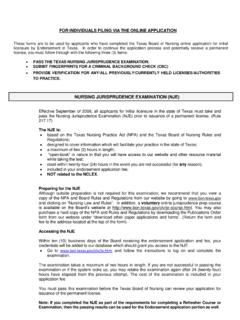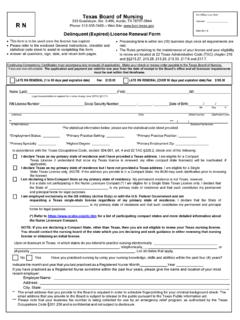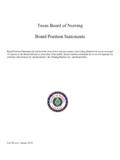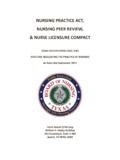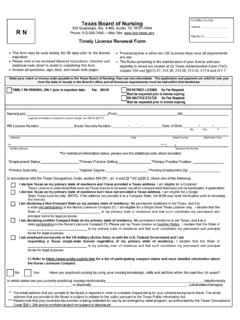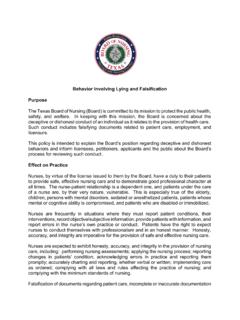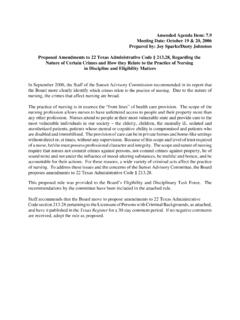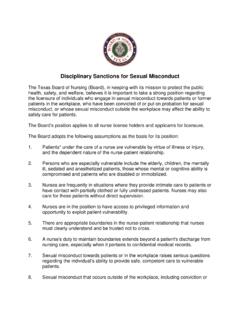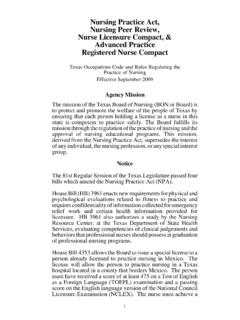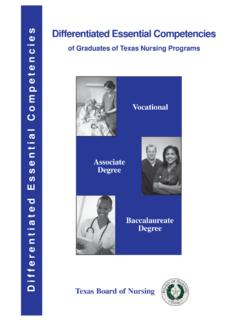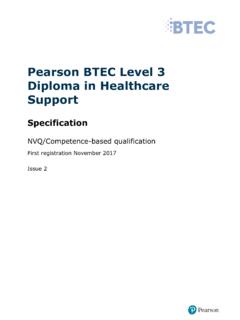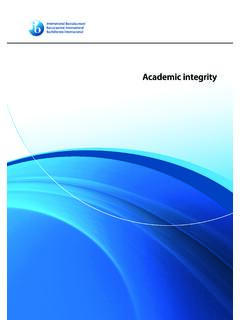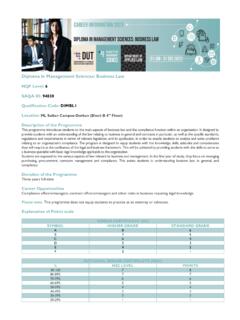Transcription of Differentiated Essential Competencies - Texas
1 Differentiated Essential Competencies Differentiated Essential Competencies of Graduates of Texas Nursing Programs Vocational Associate Degree Baccalaureate Degree Texas Board of Nursing Differentiated Essential Competencies (DECs). of Graduates of Texas Nursing Programs Evidenced By Knowledge, Clinical Judgments, and Behaviors Vocational (VN). diploma /Associate Degree ( diploma /ADN). Baccalaureate Degree (BSN). (2010). Published by the Texas Board of Nursing 2011. Table of Contents History and Effectiveness of the 2002 DELC and Transition to the Values and Ethics in Executive Definition of Outline of the Implications of the Vocational Nursing Essential Competencies of Graduates of Texas Vocational Nursing Education diploma and Associate Degree Nursing Essential Competencies of Graduates of Texas diploma and Associate Degree Nursing Education Baccalaureate Degree Nursing Essential Competencies of Graduates of Texas Baccalaureate Degree Nursing Education Texas Board of Nursing Differentiated Essential Member of the Provider of Patient-Centered Patient Safety Member of the Health Care Implementing the Appendix A - Committee Appendix B - Survey Respondents - Nursing Education
2 Appendix C - Survey Respondents- Clinical Affiliating Appendix D - Employer Focus Groups for iii Introduction Differentiated Essential Competencies of Graduates of Texas Nursing Programs Evidenced by Knowledge, Clinical Judgments, and Behaviors 2010. Nursing practice in Texas by licensed nurses flows along a scope of practice continuum based upon educational preparation from the Licensed Vocational Nurse (LVN) to the doctorally prepared Registered Nurse (RN). While selected aspects of nursing care may be assigned or delegated by licensed practicing nurses to ancillary persons such as nursing assistants or aides, LVNs and RNs currently form the core in the roles identified as members of the profession, providers of patient-centered care, patient safety advocates, and members of the health care team.
3 Basic educational preparation for the LVN examination is provided at the vocational level in Texas Board of Nursing (BON or Board) approved programs in community colleges, hospitals, career schools, and the military. Educational preparation for the RN licensure examination may be obtained through Texas BON approved diploma , associate degree, and baccalaureate degree programs (including generic master's degree programs). Each of these programs provides the necessary preparation for practice as a registered professional nurse. The curricula of each of the nursing programs differ and the outcomes of the educational levels dictate a Differentiated set of Essential Competencies of graduates. The competency statements describe progression in expected behaviors across the types of programs from vocational nursing (VN) to diploma and associate degree nursing (ADN) to baccalaureate degree nursing (BSN).
4 The Competencies of each educational level build upon the previous level. History and Methodology On January 20, 2000, the then Board of Nurse Examiners (BNE) charged the Advisory Committee on Education (ACE) to review and revise the original competency document, the Essential Competencies of Texas Graduates of Education Programs in Nursing (BNE, 1993). The Board of Vocational Nurse Examiners (BVNE, later merged with the BNE) conducted a parallel process to survey vocational programs for review and revision of the VN Competencies and then joined the ACE to finalize the process. ACE instituted a subcommittee which included six nurses who represented diploma , ADN, and BSN education in addition to Texas League for Nursing (TLN) and Texas Organization of Nurse Executives (TONE) members who represented nursing practice.
5 This subcommittee met August 9, 2000 to begin the process of review and revision. The subcommittee analyzed the Essentials of Baccalaureate Education (American Association of Colleges of Nursing, 1998) and the Educational Competencies for Graduates of Associate Degree Nursing Programs (National League for Nursing, 2000). v and found that the original 14 Competencies in the Texas document were consistent with these two publications. The subcommittee also recognized that over the preceding seven years, schools of nursing used the 14 core Competencies in various ways, one of which was to revise course objectives and outcome statements. The revised document was approved in 2002. At the July 17-18, 2008 meeting of the Texas BON, the Board charged the ACE to review and revise the 2002 Differentiated Entry Level Competencies (DELC).
6 This was the first review and revision after the merger of the BVNE. and BNE in 2004. Following the methodology used for the 2002 revision, ACE appointed a DELC Work Group to lead the revision process. Members of the DELC Work Group represented VN, diploma , ADN, and BSN. education; vocational and professional nursing practice; the Licensed Vocational Nurses Association of Texas (LVNAT); the Texas Nurses Association (TNA); and the Texas Organization of Nurse Executives (TONE). Through meetings and telephone conference calls over a period of about 20 months, the work group revised the DELC, changing the title to the Differentiated Essential Competencies (DECs) and expanding the three nursing roles to four. The four roles are listed with a brief rationale for the change: $ Member of the Profession: listed as primary role to focus on the profession $ Provider of Patient-Centered Care: a change in current literature from client to patient , emphasizing patient-centered care $ Patient Safety Advocate: based upon new concerns about patient safety $ Member of the Health Care Team: relates to the nurse's participation in the health care team The core Competencies were increased from 14 in the DELC to 25 in the DECs with an increasing focus on patient safety.
7 All Competencies were updated using current literature, national standards, and research ( , the Quality and Safety Education for Nurses Competencies , the Institute of Medicine Reports, the Carnegie Report), and incorporated new focus concepts including safety, advocacy, patient-centered care, evidence-based practice, and informatics. The 25 core Competencies fall under the four nursing roles and are further delineated into a series of more specific expected clinical judgments and behaviors related to each core competency. These more detailed Competencies are preceded by the necessary content (or knowledge) needed as a basis for competency development. The knowledge statements indicate the student learning needs during the educational experience; the content determines the subject matter to be taught.
8 The knowledge should provide the tools to the student for critical thinking and reflection in clinical decision-making for safe, compassionate, and effective patient care. The program of study prepares the students (and graduates) with a knowledge base to make sound clinical judgments for their nursing behaviors and interventions. vi The revised Competencies were distributed to all Texas BON approved nursing programs for comments in September 2009. ACE members and Board staff presented information about the revised document to deans, directors, and coordinators at meetings of the vocational and professional program directors. Comments and responses were considered as further revisions of the document continued. The revised document was disseminated to affiliating agencies (including long term care, hospitals, and public health settings) and other stakeholders during the spring and summer of 2010.
9 The final revision of the DECs was presented to the Board for adoption at the October 2010 meeting. Programs will begin implementation during the 2011-2012 academic year. Competencies The Competencies are written to guide nursing programs to meet the approval criteria established by the BON and to ensure that programs prepare graduates to provide safe, competent care to the people of Texas . A competency is described as an expected level of performance that integrates knowledge, skills, abilities, and judgment (American Nurses Association, 2008, p. 3). Competencies were designed to demonstrate the progression of expectations across the types of nursing programs based upon educational preparation. It is acknowledged that it may be impossible to evaluate students' abilities on some of the Competencies since new graduates will grow from novice to advanced beginner as they transition into practice (Benner, 1984; National Council of State Boards of Nursing, 2006).
10 It is expected that the education should have prepared the graduate with a background to demonstrate these advanced Competencies which are italicized and identified by an asterisk in the document. All of the Competencies may be utilized to develop curriculum. There may seem to be redundancy in the Competencies within the DECs but the redundancy is intentional. The document was designed so that sections related to a specific competency or educational level could be separated and could stand alone from the larger document. Most Competencies build across educational levels and yet some of the Competencies are the same across levels. For example, a general high level of safety is expected across all levels of nursing practice.
